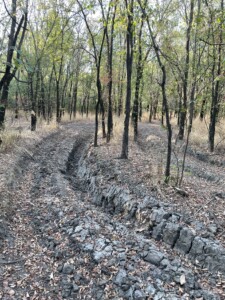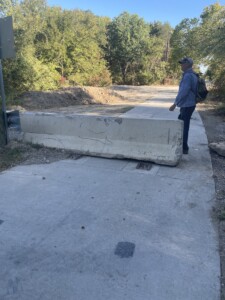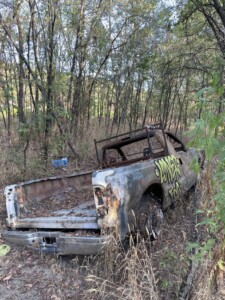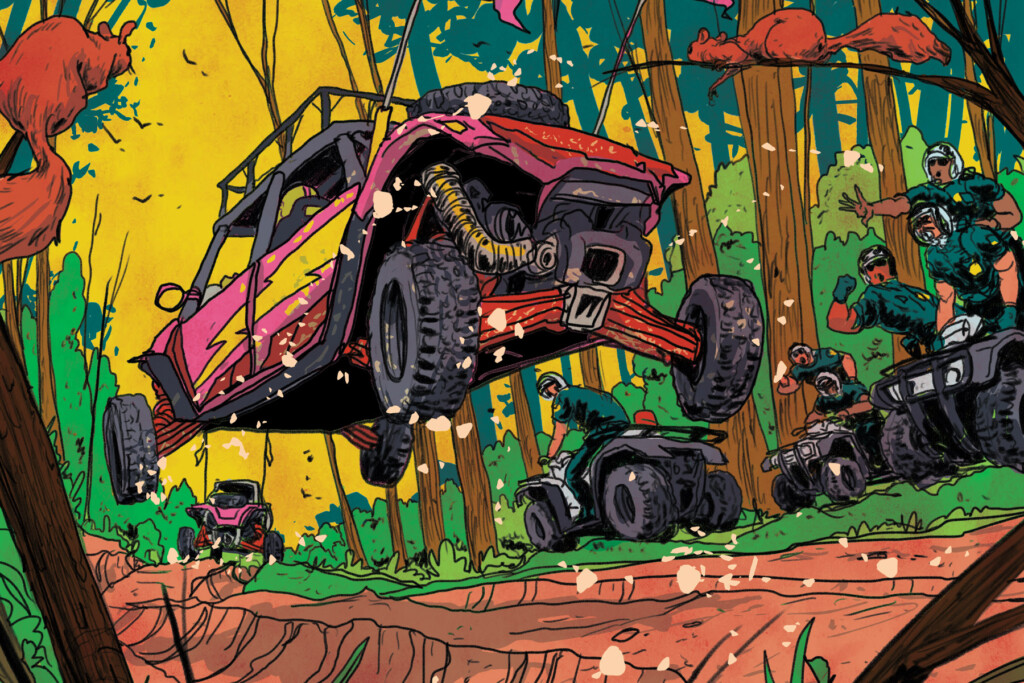From November 2023

The Great Trinity Forest Gateway and Horse Trail is a quaint park anchored by a fishing pond and a pavilion encircled by a half-mile concrete jogging loop. On a September morning, a Cooper’s hawk sails between trees on the north side of the water, and a couple of mutt ducks—mallards that likely mated with escaped domestics—paddle near the shore on the south. It is quiet except for the thrum of Interstate 20 to our backs.
This 10-year-old park is the bookend of the forest, one of the primary access points to the 6,000 or so acres of woods near the city’s southern border. A concrete path splits from the jogging trail and leads out of the park and into the hackberries and elms, the start of about a 2-mile walk to the limestone-cragged overlook called the McCommas Bluff Preserve. If you’re willing to slog through some brush, it’s another 10-minute hike north to the Trinity River Audubon Center, the city’s educational centerpiece for the forest.
The best way to get there? “Follow the Modelos,” says Ben Sandifer, the 6-foot-8 genial giant who has become one of the handful of citizen protectors of this vast land. The accountant found his passion in these woods a decade ago, something that channeled his inner Boy Scout and pushed him to become a serious naturalist. He has an encyclopedic knowledge of the flora and fauna and human history of this overlooked part of our city, dating back to before Native Americans settled above the Trinity River.
The Modelos are a bit of a bummer for Sandifer. The empty cases and spent bottles are a reminder that not everyone cherishes this place like he does. Another sign: the tire tracks.
Lately, Sandifer has been wearing out his 311 app reporting illegal ATVs. He says he noticed an uptick in activity in 2019, but the real action started during the pandemic and hasn’t let up. The vehicles tear up hiking trails and delicate ecosystems. Back in the woods stands Bur Oak No. 292, a centuries-old tree cataloged by the city and marked by a blue tag. A few feet away, 3- and 4-foot-deep tire ruts cut through the soft bottomland clay. ATV riders have destroyed trails meant for hiking or horses. When the tracks get too deep, the riders just create new ones.
Marshals are the main law enforcers within all of the city’s public parkland, which, including what has been developed and what is coming, totals 20,118 acres. (There are also a dozen park rangers, but they aren’t sworn officers.) The marshals work with the Code Compliance Department to break up parties, while Dallas police patrol bordering streets.
But Dallas has only a dozen marshals for all those acres. The newly approved budget includes money to hire another eight, and the parks director would like to hire 10 more every year until the division gets staffed up to 100. The city owns just three Honda Rubicon 4x4s, and one was in the shop in September. Longer-term plans call for larger ATVs and surveillance drones, says Chief Marshal David Pughes. For now, they rely on 311 complaints and review social media to get ahead.
“You have to be strategic, just like you do when you’re patrolling any other part of the city,” Pughes says. “We try to make sure that we’re doing things to prevent something from occurring, as opposed to being reactive and then getting out in the middle of the forest and there’s already 80 people on ATVs out there.”
Riders upload videos to YouTube, Instagram, and TikTok. Some take their own ATVs and side-by-sides into the forest, but there are also businesses that rent the machines by the hour. One of those operations used the Instagram account @dallas_offroad_rentals, which encouraged customers to arrange times via direct message. One weekend not long ago, the account announced it was shuttering, and it posted a phone number for deposit refunds.
The number was the cell of Jeremy Ramos, a 27-year-old Ennis resident who tells me he split from his business partner with whom he “just didn’t see eye to eye anymore over a few things,” declining to elaborate. Ramos says he’s been “riding my whole life.” He started by working on ATVs and UTVs in a shop but realized there was a market for renting them. His business, he says, prioritizes families and kids, even organizing “tours,” as he calls them, for children with autism. He says he has a four-seater Polaris RZR side-by-side, a two-seater Can-Am Maverick X3, and six four-wheelers. RZRs generally have 135 horsepower (a standard sedan has between 180 and 200), while the Can-Am Maverick has 200. The city’s Rubicons top out at around 30 horsepower. The higher-end machines can range from $20,000 to $40,000.
Ramos says he doesn’t lead his clients into public land. He takes people out in Mineola and Jacksonville, both of which are about two hours east of town. In Dallas, he says, he keeps to 20 acres of private property owned by a friend. There are videos online of the old company taking tours into the forest; Ramos says those videos were recorded three years ago.




His friend’s private property is on Dowdy Ferry Road, just south of Interstate 20, on the other side of the Gateway Park. Marshals believe this is one of the many places where ATV riders access the public parts of the forest. The two-lane stretch south of the freeway is a line to Dallas’ southernmost point, a mishmash of scrap yards and assorted automotive businesses that has risen adjacent to the Trinity River. The private land often extends to the water; follow that, and you can zoom under Interstate 20 and into the city-owned forest.
Ramos says it’s too risky to take people in. “You go riding in those horse trails in the back and you injure yourself, then you’ve got EMS trying to find you and you’re out of pocket,” he says. “You’re definitely going to get in trouble when everything gets settled.”
The marshals report complaints of some property owners charging for ATV riders to use their land, which they verify by way of permits. Usually, they say, the landowners don’t have permission to run this type of business. But catching these people still often requires someone reporting the issue to 311.
That’s what generated an abnormal police presence on Dowdy Ferry Road the Sunday before Labor Day. Party promoters had spent the week prior on Instagram marketing a day-long event at an address of a scrap yard. Four patrol cars were on site: one driving toward Interstate 20; another parked, bored officer inside, on a shoulder within eyesight of a toilet that had been tossed into the woods; a third semi-hidden on a side street; and the fourth keeping watch from near a salvage yard. Everything was quiet at 3 pm, though, an idling taco truck the only suggestion that something larger had been planned. A truck hauling an ATV pulled to the shoulder and then drove away.
Sandifer has been wearing out his 311 app reporting illegal ATVs. The real action started during the pandemic and hasn’t let up.
“This part of town is new to me,” said Sgt. Robert Hollingsworth, who sat in his patrol car pointed at Dowdy Ferry. It’s easy to see why this is a perfect setting for bands to set up on utility trailers to play a soundtrack for four-wheel action, even if the police presence kills a party every so often, as was the case this Sunday. By the way, the ticket for illegally riding an ATV through the forest brings a maximum fine of $236.
Sandifer and other citizen watchdogs worry that unchecked gas-powered gallivanting will wreck Dallas’ most overlooked—and mistreated—natural asset, just as the city and private donors have invested millions into improving access here. The 50-mile Loop trail will, for the first time, connect existing trails north of Interstate 30 by way of a new 9-mile trail that extends from near White Rock Lake to the northern edge of the forest. Including the rehabilitation of city streets and a bridge over an active Union Pacific rail line, the total cost will likely approach $90 million.
The city is working with the nonprofit Trust for Public Land to connect the forest with trails along Five Mile Creek, in southern Oak Cliff. The Trust has raised about $35 million, which will likely be less than half of the project’s total cost. Closer to the forest, the city, in 2021, paid $750,000 to acquire 124 acres off Dowdy Ferry that were once part of the private Dallas Hunting and Fishing Club. That’s a lot of money to invest in greenspace just to then leave it unprotected.
Walk five minutes out of the Gateway Park and into the forest, and you’ll find a bombed-out Ford F-150 that has been sprayed with graffiti. There are crude hunks of concrete that act as barriers to keep ATVs and other machinery away from private property. Some property owners have made blockades with felled trees. Other parts of the forest appear to have been clear-cut with heavy machinery. Mounds of shingles sit in front of “NO DUMPING” signs like a middle finger. A metal sign warning of “WATER CROSSING” bears buckshot marks. Discarded tents and sleeping bags lie strewn about.
“It’s just devastating,” Sandifer says, taking it all in. Looking up at Bur Oak No. 292, he appears to have shrunk by half a foot. He’s standing in a rut created by the ATVs.
This story originally appeared in the November issue of D Magazine with the headline, “Riding Dirty.” Write to [email protected].
Author







